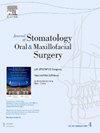Molecular profiling of oral epithelial dysplasia and oral squamous cell carcinoma using next generation sequencing
IF 1.8
3区 医学
Q2 DENTISTRY, ORAL SURGERY & MEDICINE
Journal of Stomatology Oral and Maxillofacial Surgery
Pub Date : 2024-10-17
DOI:10.1016/j.jormas.2024.102120
引用次数: 0
Abstract
Background
Next generation sequencing (NGS) is a massive, high-throughput sequencing technology used to analyze various mutations and genetic changes in cancer. Oral squamous cell carcinoma (OSCC) is the most common malignancy of the head and neck region. OSCC usually arises from oral potentially malignant disorders, like oral leukoplakia, oral submucous fibrosis and erythroplakia, and shows mutation of tumor suppressor genes, and several other critical genes involved in apoptotic pathways, cell migration, and cell growth.
Aim
To analyze the molecular profiles of oral epithelial dysplasia and different grades of oral squamous cell carcinoma using NGS in the Indian subpopulation.
Methodology
21 patients (5 patients each of well differentiated, moderately differentiated, poorly differentiated squamous cell carcinoma, severe epithelial dysplasia, and 1 normal appearing mucosal tissue from apparently healthy individuals) were included in the study. Next generation sequencing was carried out using 50 hotspot gene panel. Protein-protein analysis was carried out using STRING Consortium 2023 and the methylation profile of the expressed genes was evaluated using the UALCAN portal.
Results
Severe epithelial dysplasia showed TP53 (c.743G>A, p.R248Q) pathogenic mutations (SNV) in suboptimal QC parameters. Well differentiated squamous cell carcinoma showed TP53 (c.328delC, p.Arg110fs*13), APC (c.4135G>T, p.Glu1379*), and FBXW7 (c.832C>T, p.Arg278*) mutations. CTNNB1 (c.134C>T, p.Ser45PheS45F), TP53 (c.637C>T, Arg213TerR213*), NRAS (c.183A>C, p.Gln61HisQ61H) and PDGFRA (c.1672C>T, p.Arg558Cys) mutations were seen in moderately differentiated squamous cell carcinoma. No pathogenic mutations were evident in poorly differentiated squamous cell carcinoma. STRING analysis showed that all the expressed proteins in each group were interrelated to each other. No significant difference was evident in the methylation profile of all the expressed genes when compared to the normal controls.
Conclusion
The results obtained in this study explain the diverse genetic mutations in various grades of oral squamous cell carcinoma. Identification of these mutations would help in providing better treatment, designing a proper treatment plan for the patients with OSCC and support minimal intervention medicine.
利用新一代测序技术分析口腔上皮发育不良和口腔鳞状细胞癌的分子特征。
背景:新一代测序(NGS)是一种大规模、高通量的测序技术,用于分析癌症中的各种突变和基因变化。口腔鳞状细胞癌(OSCC)是头颈部最常见的恶性肿瘤。OSCC通常源于口腔潜在恶性疾病,如口腔白斑病、口腔黏膜下纤维化和红斑病,表现出抑癌基因和其他一些参与细胞凋亡途径、细胞迁移和细胞生长的关键基因的突变。目的:在印度亚群中使用 NGS 分析口腔上皮发育不良和不同等级口腔鳞状细胞癌的分子特征。方法:研究共纳入 21 例患者(分化良好、中度分化、分化不良的鳞状细胞癌和严重上皮发育不良患者各 5 例,来自表面健康个体的正常粘膜组织 1 例)。使用 50 个热点基因面板进行了新一代测序。使用STRING Consortium 2023进行蛋白质-蛋白质分析,并使用UALCAN门户网站评估表达基因的甲基化情况:结果:严重上皮发育不良显示出TP53(c.743G>A, p.R248Q)致病基因突变(SNV),QC参数不达标。分化良好的鳞状细胞癌显示出 TP53(c.328delC,p.Arg110fs*13)、APC(c.4135G>T,p.Glu1379*)和 FBXW7(c.832C>T,p.Arg278*)突变。CTNNB1 (c.134C>T, p.Ser45PheS45F), TP53 (c.637C>T, Arg213TerR213*), NRAS (c.183A>C, p.Gln61HisQ61H) 和 PDGFRA (c.1672C>T, p.Arg558Cys) 突变出现在中度分化的鳞状细胞癌中。在分化较差的鳞状细胞癌中未发现明显的致病突变。STRING分析表明,每组中所有表达的蛋白质都相互关联。与正常对照组相比,所有表达基因的甲基化谱无明显差异:本研究的结果解释了不同等级口腔鳞状细胞癌中存在的多种基因突变。确定这些基因突变有助于为 OSCC 患者提供更好的治疗、设计适当的治疗方案以及支持最小干预医学。
本文章由计算机程序翻译,如有差异,请以英文原文为准。
求助全文
约1分钟内获得全文
求助全文
来源期刊

Journal of Stomatology Oral and Maxillofacial Surgery
Surgery, Dentistry, Oral Surgery and Medicine, Otorhinolaryngology and Facial Plastic Surgery
CiteScore
2.30
自引率
9.10%
发文量
0
审稿时长
23 days
 求助内容:
求助内容: 应助结果提醒方式:
应助结果提醒方式:


